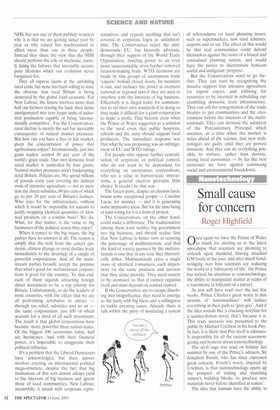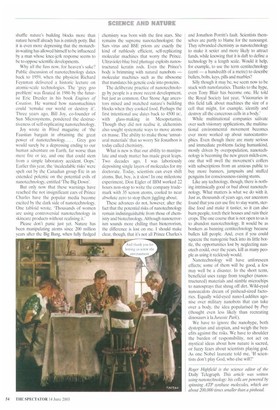Small cause for concern
Roger Highfield
nnce again we have the Prince of Wales
to thank for alerting us to the latest apocalypse that scientists are planning to unleash upon mankind. Having attacked GM foods in the past, and after much handwringing over how scientists are reducing the world to a 'laboratory of life', the Prince has turned his attention to nanotechnology, the ability to manipulate matter at scales of a rianometre (a billionth of a metre).
As you will have read over the last few weeks, Prince Charles's great worry is that swarms of `nanornachines' will reduce everything in their path to 'grey goo'. And if the idea sounds like a cracking storyline for a science-fiction novel, that's because it is. This scary scenario was presented to the public by Michael Crichton in his book Prey. In fact, it is likely that Prey itself is ultimately responsible for all the current scaremongering and hysteria about nanotechnology.
The sci-fi saga was read on holiday last summer by one of the Prince's advisers, Sir Jonathon Porritt, who has since expressed great concern. Porritt's worry, inspired by Crichton, is that nanotechnology opens up the prospect of mixing and matching nature's building blocks 'to produce new materials never before identified in nature'.
The idea that humans have the ability to shuffle nature's building blocks more than nature herself already has is entirely potty. But it is even more depressing that the monarchin-waiting has allowed himself to be influenced by a man whose knee-jerk response seems to be to oppose scientific developments.
Why all the fuss now, for heaven's sake? Public discussion of nanotechnology dates back to 1959, when the physicist Richard Feynman delivered a historic lecture on atomic-scale technologies. The 'grey goo problem was floated in 1986 by the futurist Eric Drexler in his book Engines of Creation. He warned how nanomachines could 'remake our world or destroy it'. Three years ago, Bill Joy, co-founder of Sun Microsystems, pondered the destructiveness of self-replicating nanotechnology.
Joy wrote in Wired magazine of 'the Faustian bargain in obtaining the great power of nanotechnology. Grey goo would surely be a depressing ending to our human adventure on Earth, far worse than mere fire or ice, and one that could stem from a simple laboratory accident. Oops.' Earlier this year, the 'incalculable risks' were spelt out by the Canadian group Etc in an extended polemic on the potential evils of nanotechnology. entitled 'The Big Down'.
But only now that these warnings have reached the not insignificant ears of Prince Charles have the popular media become excited by the dark side of nanotechnology. One tabloid wrote, 'Thousands of women are using controversial nanotechnology in skincare products without realising it.'
Please don't panic just yet. Nature has been manipulating atoms since 200 million years after the Big Bang, when fully fledged chemistry was born with the first stars. She remains the supreme nanotechnologist: the Sars virus and BSE prions are exactly the kind of ruthlessly efficient, self-replicating molecular machines that worry the Prince. Ultraviolet-blue bird plumage exploits nanostructured keratin rods. Even the Prince's body is brimming with natural nanobots — molecular machines such as the ribosome that translates his genetic code into proteins.
The deliberate practice of nanotechnology by people is a more recent development, but just as common. Our Stone Age ancestors mixed and matched nature's building blocks when they cooked food. Perhaps the first intentional use dates back to 4500 BC, with glass-making in Mesopotamia. Though they did not realise it, alchemists also sought systematic ways to move atoms en masse. The ability to make those 'unnatural materials' that so worry Sir Jonathon is today called chemistry.
What is new is that our ability to manipulate and study matter has made great leaps. Two decades ago, I was laboriously depositing single layers of molecules for my doctorate. Today, scientists can even shift atoms. But, boy, is it slow? In one milestone experiment, Don Eigler of IBM worked 22 hours non-stop to write the company trademark with 35 xenon atoms, cooled to near absolute zero to stop them jiggling about.
These advances do not, however, alter the fact that the potential risks of nanotechnology remain indistinguishable from those of chemistry and biotechnology. Although nanoterrorism sounds more chilling than bioterrorism, the difference is lost on me. I should make clear, though, that it's not all Prince Charles's and Jonathon Porritt's fault. Scientists themselves are partly to blame for the nanoangst. They rebranded chemistry as nanotechnology to make it sexier and more likely to attract funds, while knowing that it is daft to define a technology by a length scale. Would it help, for example, to use the term centitechnology (centi — a hundredth of a metre) to describe bullets, bolts, keys, pills and marbles?
Silly though it may be, we seem now to be stuck with nanofanatics. Thanks to the hype, even Tony Blair has become one. He told the Royal Society last year, 'Visionaries in this field talk about machines the size of a cell that might, for example, identify and destroy all the cancerous cells in a body.'
While multinational companies salivate over such visionary applications, the multinational environmental movement becomes ever more worked up about nanocatastrophies. Even though there are many serious and immediate problems facing humankind, mostly driven by overpopulation, nanotechnology is becoming the new green milch-cow, one that will swell the movement's coffers with subscriptions from an anxious public to buy more banners, jumpsuits and stuffed penguins for consciousness-raising stunts.
Like any technology, though, there is nothing intrinsically good or bad about nanotechnology. What matters is what we do with it. Just as, thousands of years ago, our ancestors found that you can use fire to stay warm, sterilise food and make it tastier, so it can also burn people, torch their houses and ruin their crops. The one course that is not open to us is to abandon nanotechnology. It would be as bonkers as banning centitechnotogy because bullets kill people. And, even if you could squeeze the nanogenie back into its little bottle, the opportunities lost by neglecting nanotech could, over the years, kill as many people as using it recklessly would.
Nanotechnology will have unforeseen effects; some of them will be good, a few may well be a disaster. In the short term, beneficial uses range from tougher (nanostructured) materials and nimble microchips to nanosprays that shrug off dirt. Wild-eyed nanozealots dream of pinhead-sized factories. Equally wild-eyed nano-Luddites agonise over militay nanobots that can take over a body, the idea popularised by Prey (thought even less likely than recreating dinosaurs a la Jurassic Park).
We have to ignore the nanohype, both dystopian and utopian, and weigh the benefits against the risks. We have to shoulder the burden of responsibility, not act on mystical ideas about how nature is sacred, or fuzzy fears about scientists playing god. As one Nobel laureate told me, 'If scientists don't play God, who else will?'
Roger Highfield is the science editor of the Daily Telegraph. This article was written using nanotechnology: his cells are powered by spinning ATP synthase molecules, which are about 200,000 times smaller than a pinhead



































































































 Previous page
Previous page